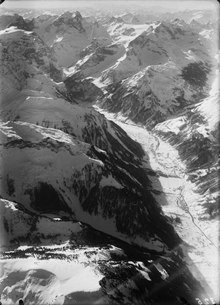Rüti GL
| GL is the abbreviation for the Canton of Glarus in Switzerland and is used to avoid confusion with other entries of the name Rüti . |
| Rüti | ||
|---|---|---|
| State : |
|
|
| Canton : |
|
|
| District : | No district division | |
| Political community : | Glarus South | |
| Postal code : | 8782 | |
| former BFS no. : | 1626 | |
| UN / LOCODE : | CH RTI | |
| Coordinates : | 720.15 thousand / 199 758 | |
| Height : | 616 m above sea level M. | |
| Area : | 6.18 km² | |
| Residents: | 364 (December 31, 2010) | |
| Population density : | 59 inhabitants per km² | |
| Website: | www.rueti-gl.ch | |
| map | ||
|
|
||

Rüti (GL) is a village in the political municipality of Glarus Süd in the canton of Glarus in Switzerland .
geography
Rüti is a street village in the Glarus valley. It is located on the right bank of the Linth near the mouth of the Durnagels . 4.9% of the former municipal area is settled, 23.9% are used for agriculture, 57.3% are forested and 13.9% are unproductive.
population
| year | Residents |
|---|---|
| 1700 | 270 |
| 1837 | 800 |
| 1930 | 1,000 |
| 1941 | 670 |
| 1990 | 504 |
| 2003 | 389 |
| 2010 | 364 |
Around 1900, the textile factories attracted many guest workers who settled in the community. Rüti therefore has the highest proportion of foreigners in the canton of Glarus, at 35 percent. In 1980, 80 percent of the workforce was employed in domestic industry.
economy
Agriculture was the most important source of income until industrialization. The utilization of water power from Linth and Marglenbach made it possible to operate a cotton spinning mill in 1846 and a wool weaving mill in 1850, both of which were taken over by the Schoeller's worsted yarn mill from Rudolf Wilhelm Schoeller , but had to close in 2002.
traffic
The Glarus - Linthal railway has a stop in Rüti. As early as 1879, Rüti was connected to the Weesen – Linthal line . The main road for individual traffic is outside the village center.
history
The Rüti was first mentioned in a document around 1340. In 1388, the oldest Linth bridge in the state of Glarus is documented in Rüti. After being replaced by the church in Glarus, the residents of Rüti have been part of the church in Betschwanden since 1300 . In 1528 the inhabitants joined the Reformation . In the playground remains of walls have been preserved a medieval residential tower. The house, built in the 16th century, played an important role in the history of the community. Here court was held and road tolls were levied. In 1939 the separation from Braunwald took place. The former Rütis alpine region became independent.
The collapse of the textile industry has resulted in a sharp decline in population and tax revenue. As a result, the municipality went into debt and was placed under cantonal supervision. The two municipal alps Bodmen and Vorder Durnachtal were to be sold to repay debt . With a collection campaign, initiated by Heiri Hösli from Ennetbergen and supported by the Ruessdiliverein , the Swiss sponsorship for mountain communities and the authorities, the Alp Bodmen in 2004 and Alp Vorder Durnachtal in 2006 were saved from being sold out and transferred to a foundation.
Rüti was merged with the municipalities of Betschwanden , Braunwald , Elm , Engi , Haslen , Linthal , Luchsingen , Matt , Mitlödi , Schwanden (GL) , Schwändi , and Sool to form the new municipality of Glarus Süd on January 1, 2011 as part of the Glarus municipal reform .
The municipality of Buchs ZH has taken on a sponsorship for Rüti.
Web links
- Website of the Rüti GL village association
- Karin Marti-Weissenbach: Rüti (GL). In: Historical Lexicon of Switzerland .
Individual evidence






